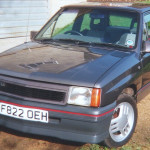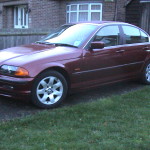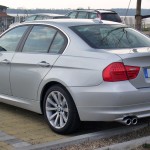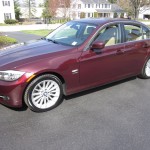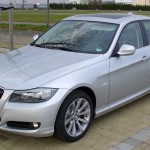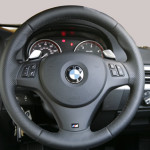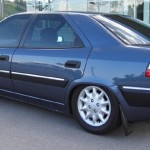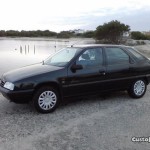Your relationship with your car tends to be one of two things: relatively fleeting and transactional, as you replace it rapidly; or something you relax into over time, much like an old and much-loved pair of boots. For some it could also be a hate-hate relationship, thinking of infamous episode where Basil Fawlty beats his car; I’ve known plenty of people for whom car issues become a bigger topic of conversation than the weather, and in Britain that really is saying something.
Cars have improved markedly in my time, even if they are still using refinements of the same internal combustion engines that originated in the 19th Century. Courtesy of Wikipedia:
Internal combustion engines
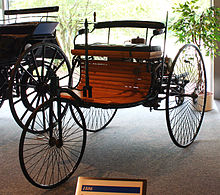
1885-built Benz Patent Motorwagen, the first car to go into production with an internal combustion engine
Early attempts at making and using internal combustion engines were hampered by the lack of suitable fuels, particularly liquids, therefore the earliest engines used gas mixtures.
Early experimenters used gases. In 1806, Swiss engineer François Isaac de Rivaz who built an engine powered by internal combustion of a hydrogen and oxygen mixture. In 1826, Englishman Samuel Brown who tested his hydrogen-fuelled internal combustion engine by using it to propel a vehicle up Shooter’s Hill in south-east London. Belgian-born Etienne Lenoir‘s Hippomobile with a hydrogen-gas-fuelled one-cylinder internal combustion engine made a test drive from Paris to Joinville-le-Pont in 1860, covering some nine kilometres in about three hours.[14] A later version was propelled by coal gas. A Delamare-Deboutteville vehicle was patented and trialled in 1884.
About 1870, in Vienna, Austria (then the Austro-Hungarian Empire), inventor Siegfried Marcus put a liquid-fuelled internal combustion engine on a simple handcart which made him the first man to propel a vehicle by means of gasoline. Today, this car is known as “the first Marcus car”. In 1883, Marcus secured a German patent for a low-voltage ignition system of the magneto type; this was his only automotive patent. This design was used for all further engines, and the four-seat “second Marcus car” of 1888/89. This ignition, in conjunction with the “rotating-brush carburetor“, made the second car’s design very innovative.
It is generally acknowledged that the first really practical automobiles with petrol/gasoline-powered internal combustion engines were completed almost simultaneously by several German inventors working independently: Karl Benz built his first automobile in 1885 in Mannheim. Benz was granted a patent for his automobile on 29 January 1886, and began the first production of automobiles in 1888, after Bertha Benz, his wife, had proved – with the first long-distance trip in August 1888, from Mannheim to Pforzheim and back – that the horseless coach was absolutely suitable for daily use. Since 2008 a Bertha Benz Memorial Route commemorates this event.
Soon after, Gottlieb Daimler and Wilhelm Maybach in Stuttgart in 1889 designed a vehicle from scratch to be an automobile, rather than a horse-drawn carriage fitted with an engine. They also are usually credited with invention of the first motorcycle in 1886, but Italy’s Enrico Bernardi of the University of Padua, in 1882, patented a 0.024 horsepower (17.9 W) 122 cc (7.4 cu in) one-cylinder petrol motor, fitting it into his son’s tricycle, making it at least a candidate for the first automobile, and first motorcycle; Bernardi enlarged the tricycle in 1892 to carry two adults.
One of the first four-wheeled petrol-driven automobiles in Britain was built in Birmingham in 1895 by Frederick William Lanchester, who also patented the disc brake; and the first electric starter was installed on an Arnold, an adaptation of the Benz Velo, built between 1895 and 1898.
George F. Foss of Sherbrooke, Quebec built a single-cylinder gasoline car in 1896 which he drove for 4 years, ignoring city officials’ warnings of arrest for his “mad antics.”
In all the turmoil, many early pioneers are nearly forgotten. In 1891, John William Lambert built a three-wheeler in Ohio City, Ohio, which was destroyed in a fire the same year, while Henry Nadig constructed a four-wheeler in Allentown, Pennsylvania. It is likely they were not the only ones.
Unless the supply of oil expires or becomes prohibitively expensive, it seems unlikely that electric cars or even hybrids will become the most popular mode of personal transport any time soon, let alone any other technology, and goodness knows we are wedded to our cars, whatever governments try to do to entice us out into public transport.
But then cars are extensions of our homes, a personal space which says many things about us than simply our desire to get from A to B. And in some cases, definitely phallic symbols.
I’ve been accused of buying Beamers as a status symbol, but as with all things brand awareness for me is about liking a quality product, not associating myself with a lifestyle defined by marketing. That would in my estimation be shallow and imply my ego was more than a little fragile. Since it is not, I’m happy to report that my aim has always been to find a car that fits me and does what I need it to do – and I’m very pleased to say that I got there in the end, though not without plenty of mistakes along the way.
Over the years I’ve driven a fair assortment of vehicles, some of which were “company cars” one way or another. My first was courtesy of my dad, when I was still in the 6th form: a Ford Cortina 2000 GXL Auto, well impressive to the other lads but sadly making little impact with the girls. It also made an unfortunate exit when I was parked by a mate’s house only for some blind bugger to reverse into the front of it!! My memory is a bit hazy after that, but I think there was an insurance impasse. At any rate, the car was not fixed and fell into rack and ruin through no fault of mine! Shame indeed.
For some years I drove terrible cars, entirely through lack of choice. There was a Morris Marina, which you had to coax around bends with great caution, as if paddling a canoe across a gorge. Not easy, but that was undoubtedly better than the snot green Fiat 124 I was given for a short period after that, the model used as the basis for early Ladas, you may remember and which my friend Nigel drove for some years – tank-like without ever inspiring confidence. You never quite knew whether you would get home in that particular car, so it was not a day for sadness when I left the job with which it came.
I started buying my own wheels around the mid-80s, though there were more forgettable ones along the way: an MG Metro that was also less than reliable; a Vauxhall Nova that was a magnet to incompetent car thieves, who succeeded in damaging doors and locks but never actually breaking in; later there was a Citroën ZX, my first diesel, and later a tardis-like Citroën Xantia that ferried around my family, later my parents, and later still my sister and her family.
By and large, I’ve kept my cars a decent time since I started buying them – notably 15 years between the last two BMWs, which speaks volumes for the cars. I’ve resisted the temptation to name them, but they have always been there for me. We’ve had a few downs along the way, but many more ups. First there was a petrol-engined 328i in a rich shade of burgundy, then my current motor – a 330D in silver. The attractions of the car have always been obvious to me. Right from the start I knew the engine is up there with , the best, and one I would recommend to anyone looking for a high-performance engine capable of good fuel economy on a long run. Far cry from the days when diesels were slow, sluggish, smelly and clattered like a ropey old tractor. It’s smooth, ever-ready, has bags of torque to pull me out of any situation, and when I put my foot down it’s sugar off a shovel!
Being a Beamer, it handles beautifully under most circumstances, the exception being snow or mud, the only times when rear-wheel drive is a pain in the proverbials. That was how I came to get stuck in the snow and spend my first night in this house without a stick of furniture on 16 Dec 2009! That was one of very few occasions when 4-wheel drive would have been helpful, but usually traction is most excellent.
Of course, much of my driving tends to be at cruising speeds on A-roads and motorways, so I’ve learned the value of a few extras to make life a tad easier – though that may also be a function of me getting older. These days central locking, electric windows and air conditioning are standard wherever you look, but for me auto transmission has become totally essential, leather seats make everything seem more comfortable, and best of all adaptive cruise control. I swear that on days when I’ve been dog tired, this system has saved my life by virtue of braking automatically to prevent me hitting the car in front. Some day it will be compulsory on all cars, but for now it’s a very well worthwhile investment that I recommend wholeheartedly. Doubtless the next Millwardmobile will have a range more features to entertain me for the coming 7 years or so, though how many are essential or worth the cost is debatable.
This car has performed pretty darn well for more than 150,000 miles, but is starting to get a tad expensive now (diesel particulate filters spring to mind.) Where before I bought my cars up front, now I will consider leasing with a maintenance contract, saving any worry about unforeseen costs. At any rate, an affordability test will come into the equation, so there may be compromises along the way – but it will be just as hard to part with the truly excellent 3-litre diesel engine as it will to acclimatise to anything less capable – though I suspect that technology improvements mean most engines are now infinitely more willing and durable than even a few years ago.
PS. See also my review of a courtesy car I was recently given by Cooper BMW – a Mini One Convertible.
PPS. My next BMW




